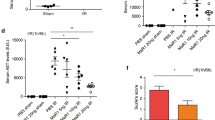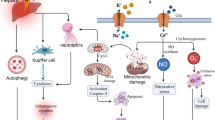Abstract
Hepatic ischemia/reperfusion injury (IRI) still remains an unavoidable problem in hepatectomy. The inflammatory response plays an important role in its pathogenesis. The plasma membrane-bound G protein-coupled bile acid receptor (TGR5), as one of G protein-coupled receptor (GPCR) families, has been proved to serve a protective role in several liver diseases. However, the exact function of TGR5 in modulating IRI remains obscure. We injected wild mice with a small interfering RNA of TGR5 (si-TGR5) or TGR5 agonist (INT-777) and established liver partial warm ischemia/reperfusion model. The results showed that knockdown of TGR5 significantly aggravated hepatic tissue injury, but treatment with INT-777 could reverse it, as evidenced by serum ALT and AST tests, liver histological injury, cytokines expressions, liver immunohistochemical analysis, and TUNEL staining. The apoptosis-associated proteins were evaluated after reperfusion. Moreover, we used primary bone marrow–derived macrophages (BMDMs) to establish hypoxia/reoxygenation (H/R) model to verify the anti-inflammation effect of TGR5. In in vivo experiments, we used TGR5-siRNA and TGR5 agonist (INT-777) to determine that TGR5 significantly attenuated liver damage after IRI through activating the Keap1-Nrf2 pathway. In addition, we found that overexpression of INT-777-activated TGR5 could reduce oxidative stress and inflammatory response in H/R-induced BMDMs through regulation of Keap1-Nef2 pathway during in vitro experiment. Importantly, these results were completely reversed in si-TGR5 BMDMs. In conclusion, the results indicated that TGR5 could effectively alleviated inflammation response via accelerating the activation of Keap1-Nrf2 signaling pathway during hepatic IRI, which may be meaningful in reducing related inflammatory molecules and adjusting inherent immunity.







Similar content being viewed by others
References
Pols, T.W., M. Nomura, T. Harach, et al. 2011. TGR5 activation inhibits atherosclerosis by reducing macrophage inflammation and lipid loading. Cell Metabolism 14: 747–757.
Rao, J., J. Qin, X. Qian, L. Lu, P. Wang, Z. Wu, Y. Zhai, F. Zhang, G. Li, and X. Wang. 2013. Lipopolysaccharide preconditioning protects hepatocytes from ischemia/reperfusion injury (IRI) through inhibiting ATF4-CHOP pathway in mice. PLoS One 8: e65568.
Chen, F., Y.M. Zhang, J.T. Wang, J. Wang, Z.L. Cui, and Z.R. Liu. 2019. Pre-treatment with FK506 reduces hepatic ischemia-reperfusion injury in rats. Clinics and Research in Hepatology and Gastroenterology 43: 161–170.
Zhai, Y., H. Petrowsky, J.C. Hong, R.W. Busuttil, and J.W. Kupiec-Weglinski. 2013. Ischaemia-reperfusion injury in liver transplantation--from bench to bedside. Nature Reviews. Gastroenterology & Hepatology 10: 79–89.
Lee, L.Y., C. Harberg, K.A. Matkowskyj, S. Cook, D. Roenneburg, S. Werner, J. Johnson, and D.P. Foley. 2016. Overactivation of the nuclear factor (erythroid-derived 2)-like 2-antioxidant response element pathway in hepatocytes decreases hepatic ischemia/reperfusion injury in mice. Liver Transplantation 22: 91–102.
Kaczorowski, D.J., A. Tsung, and T.R. Billiar. 2009. Innate immune mechanisms in ischemia/reperfusion. Front Biosci (Elite Ed) 1: 91–98.
Qiao, Y.L., J.M. Qian, F.R. Wang, Z.Y. Ma, and Q.W. Wang. 2014. Butyrate protects liver against ischemia reperfusion injury by inhibiting nuclear factor kappa B activation in Kupffer cells. The Journal of Surgical Research 187: 653–659.
Pols, T.W., L.G. Noriega, M. Nomura, J. Auwerx, and K. Schoonjans. 2011. The bile acid membrane receptor TGR5 as an emerging target in metabolism and inflammation. Journal of Hepatology 54: 1263–1272.
Deutschmann, K., M. Reich, C. Klindt, C. Dröge, L. Spomer, D. Häussinger, and V. Keitel. 2018. Bile acid receptors in the biliary tree: TGR5 in physiology and disease. Biochimica et Biophysica Acta - Molecular Basis of Disease 1864: 1319–1325.
Wang, Y.D., W.D. Chen, D. Yu, B.M. Forman, and W. Huang. 2011. The G-protein-coupled bile acid receptor, Gpbar1 (TGR5), negatively regulates hepatic inflammatory response through antagonizing nuclear factor kappa light-chain enhancer of activated B cells (NF-kappaB) in mice. Hepatology 54: 1421–1432.
Guo, C., H. Qi, Y. Yu, et al. 2015. The G-protein-coupled bile acid receptor Gpbar1 (TGR5) inhibits gastric inflammation through antagonizing NF-kappaB signaling pathway. Frontiers in Pharmacology 6: 287.
de Oliveira, M.C., E.H. Gilglioni, B.A. de Boer, J.H. Runge, D.R. de Waart, C.L. Salgueiro, E.L. Ishii-Iwamoto, R.P.J. Oude Elferink, and I.C. Gaemers. 2016. Bile acid receptor agonists INT747 and INT777 decrease oestrogen deficiency-related postmenopausal obesity and hepatic steatosis in mice. Biochimica et Biophysica Acta 1862: 2054–2062.
Yang, H., H. Zhou, L. Zhuang, J. Auwerx, K. Schoonjans, X. Wang, C. Feng, and L. Lu. 2017. Plasma membrane-bound G protein-coupled bile acid receptor attenuates liver ischemia/reperfusion injury via the inhibition of toll-like receptor 4 signaling in mice. Liver Transplantation 23: 63–74.
Zhuang, L., Y. Fan, L. Lu, W. Ding, C. Ni, X. Wang, F. Zhang, and J. Rao. 2016. Ischemic preconditioning protects hepatocytes from ischemia-reperfusion injury via TGR5-mediated anti-apoptosis. Biochemical and Biophysical Research Communications 473: 966–972.
Makri, E., E. Cholongitas, and K. Tziomalos. 2016. Emerging role of obeticholic acid in the management of nonalcoholic fatty liver disease. World Journal of Gastroenterology 22: 9039–9043.
Guo, C., J. Su, Z. Li, R. Xiao, J. Wen, Y. Li, M. Zhang, X. Zhang, D. Yu, W. Huang, W.D. Chen, and Y.D. Wang. 2015. The G-protein-coupled bile acid receptor Gpbar1 (TGR5) suppresses gastric cancer cell proliferation and migration through antagonizing STAT3 signaling pathway. Oncotarget 6: 34402–34413.
Casaburi, I., P. Avena, M. Lanzino, D. Sisci, F. Giordano, P. Maris, S. Catalano, C. Morelli, and S. Andò. 2012. Chenodeoxycholic acid through a TGR5-dependent CREB signaling activation enhances cyclin D1 expression and promotes human endometrial cancer cell proliferation. Cell Cycle 11: 2699–2710.
Asgharpour, A., D. Kumar, and A. Sanyal. 2015. Bile acids: emerging role in management of liver diseases. Hepatology International 9: 527–533.
Kudoh, K., H. Uchinami, M. Yoshioka, E. Seki, and Y. Yamamoto. 2014. Nrf2 activation protects the liver from ischemia/reperfusion injury in mice. Annals of Surgery 260: 118–127.
Wang, W., C. Guan, X. Sun, Z. Zhao, J. Li, X. Fu, Y. Qiu, M. Huang, J. Jin, and Z. Huang. 2016. Tanshinone IIA protects against acetaminophen-induced hepatotoxicity via activating the Nrf2 pathway. Phytomedicine 23: 589–596.
Rao, J., X. Qian, G. Li, X. Pan, C. Zhang, F. Zhang, Y. Zhai, X. Wang, and L. Lu. 2015. ATF3-mediated NRF2/HO-1 signaling regulates TLR4 innate immune responses in mouse liver ischemia/reperfusion injury. American Journal of Transplantation 15: 76–87.
Funding
This work was supported by the medical research guidance project of Jiangsu Provincial Health Committee (No: Z2019027), major science and technology projects of Changzhou City (No: ZD201719), Clinical Medical Science and Technology Development Foundation of Jiangsu University (No: JLY20180084), science and technology development projects of Wujin District (No: WS201708 WS201808 WS201611), and the project funding from Young Talent Development Plan of Changzhou Health Commission (CZQM2020120).
Author information
Authors and Affiliations
Corresponding authors
Ethics declarations
Conflict of Interest
The authors declare that they have no conflict of interest.
Additional information
Publisher’s Note
Springer Nature remains neutral with regard to jurisdictional claims in published maps and institutional affiliations.
Rights and permissions
About this article
Cite this article
Zhuang, L., Ding, W., Zhang, Q. et al. TGR5 Attenuated Liver Ischemia-Reperfusion Injury by Activating the Keap1-Nrf2 Signaling Pathway in Mice. Inflammation 44, 859–872 (2021). https://doi.org/10.1007/s10753-020-01382-y
Received:
Revised:
Accepted:
Published:
Issue Date:
DOI: https://doi.org/10.1007/s10753-020-01382-y




